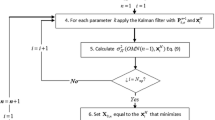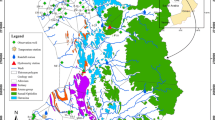Abstract
In the Daqing region of China there are 34 groundwater well fields with a groundwater withdrawal of 81.9×104 m3/d. Due to over-abstraction of the groundwater resources from the 1960s to present, a cone of depression up to 4,000 km2 has formed in the area. To monitor the change in the groundwater environment, it is necessary to design an effective groundwater-monitoring network. The sites for monitoring groundwater level were selected by applying the finite-element method coupled with Kalman filtering to the area in which the groundwater resources have been extensively exploited. The criterion is a threshold value of the standard deviation of estimation error. This threshold value is determined by the tradeoff between maximum information and minimum cost, in which the maximum information is characterized by the standard deviation and the minimum cost is equivalent to the number of observation wells. The groundwater flow model was calibrated by an optimal algorithm coupled the finite-element method with Kalman filtering by using the data from 16 observation wells from 1986 to 1993. A simulation algorithm coupled with the finite-element method with Kalman filtering analyzed the location data obtained from the existing 38 observation wells in the same region. The spatial distribution of standard deviation of estimation error is computed and the locations that have the maximum standard deviation are selected as additional sites for augmenting the existing observational well network at a given threshold value of the standard deviation surface. Based on the proposed method for selecting a groundwater level monitoring network, an optimal monitoring network with 88 observation wells with the measurement frequency of 12 times per year is selected in the Daqing region of China.









Similar content being viewed by others
References
Adamouski K, Hamory T (1983) A stochastic systems model of groundwater level fluctuations. J Hydrol 62(1/4):129–141
Bogardi I, Bardossy A, Duckstein L (1985) Multicriterion network design using geostatistics. Water Resour Res 21:199–208
Bras RL (1979) Sampling of interrelated random fields: the rainfall-runoff case. Water Resour Res 15(6):1767–1780
Carrera J, Szidarovzsky F (1985) Numerical comparison of network design algorithms for regionalized variables. Appl Math Comput 16:189–202
Carrera J, Usunoff E, Szidarovszky F (1984) A method for optimal observation network design for ground water management. J Hydrol 73:147–163
Crawford KC (1979) Considerations for the design of a hydrologic data network using multivariate sensors. Water Resour Res 15(6):1752–1762
de Marsily G (1986) Quantitative hydrogeology. Academic, San Diego
Dorn JL, Ranjithan S (2003) Evolutionary multiobjective optimization in watershed water quality management. In: Fonseca and others (eds) Evolutionary multi-criteria optimization. Lecture Notes in Computer Science, Springer, Berlin Heidelberg New York, pp 34–56
Hsu NS, Cheng KW (2000) Network optimization flow model for basin-scale water supply planning. J Water Resour Pl-ASCE 128(2):102–112
Journel A, Huijbregts C (1978) Mining geostatistics. Academic, San Diego
Knopman DS, Voss CI (1989) Multiobjective sampling design for parameter estimation and model discrimination in groundwater solute transport. Water Resour Res 25(10):2245–2258
Loaiciga HA (1989) An optimization approach for groundwater quality monitoring network design. Water Resour Res 25(8):1771–1782
Loaiciga HA, Charbeneau RJ, Everett LG, Fogg GE, Hobbs BF, Rouhani S (1992) Review of ground-water quality monitoring network design. J Hydraul Eng-ASCE 118(1):11–37
Made JW van der (1986) Design aspects of the hydrological networks. CHO Proceedings and Information No 35:172, WMO, Delft
Pinder GF, Dougherty DE, Greenwald RM (2002) Optimization and modeling for remediation and monitoring. In: Chien CC and others (eds) Environmental modeling and management: theory, practice, and future directions. Dupont workshop on modeling and management of emerging environmental Issues, Philadelphia, pp 111–185
Prakash MR, Singh VS (2000) Network design for groundwater monitoring – a case study. Environ Geol 39(6):628–632
Reed PM (2002) Striking the balance: long-term groundwater monitoring design for multiple conflicting objectives. PhD Thesis, University of Illinois
Rouhani S (1985) Variance reduction analysis. Water Resour Res 21(6):837–846
Solomatine DP (1999) Random search methods in model calibration and pipe network design. In: Savic D, Walters G (eds) Water industry system: modeling and optimization applications. Research Studies Press, Baldock, UK, pp 317–332
Spruill TB, Candela L (1990) Two approaches to design of monitoring networks. Ground Water 28(3):430–442
Van Geer FC (1982) An equation based theoretical approach to network design for groundwater levels using Kalman filters. Int Assoc Hydrol Sci Publ 136:241–250
Wilson JL, Kitanidis PK, Dettinger H (1978) State and parameter estimation in groundwater models. Proceedings of the American Geophysical Union Chapman Conference on Applications of Kalman Filter to Hydrology, Hydraulics, and Water Resources, Pittsburgh, pp 657–679
Wood EF, McLaughlin DB (1984) Groundwater monitoring well redesign. Paper presented at the NWWA/API conference on petroleum hydrocarbons and organic chemicals in groundwater: prevention, detection, and restoration, Natl Water Well Assoc, Houston
Wu Y (1992) Optimal design of groundwater level observation network. PhD Thesis, Xi ‘ an College of Geology, Xi ‘ an, China, pp 70–80 (in Chinese)
Wu Y, Bian N (2003) Optimal analysis of groundwater monitoring network of a karst aquifer. Earth Science Frontiers, No 3, (In Press, In Chinese)
Zhou Y, Te Stroot CBM, Van Geer FC (1991) Using Kalman filtering to improve and quantify the uncertainty of numerical groundwater simulations 2: Application to monitoring network design. Water Resour Res 27(8):1995–2006
Zhou Y, Van Geer FC (1992) KALMOD, a stochastic-deterministic model for simulating groundwater flow with Kalman filtering. J Sci Hydrologiques 37(4):375–389
Zidek JV, Sun WM, Le ND (2000) Designing and integrating composite network for monitoring multivariate Gaussian pollution fields. J Roy Stat Soc C-Applied Statistics 49:63–79
Acknowledgements
This work was supported by a grant from the National Natural Science Foundation of China (90102003), the Innovation Project of CAS (KZCX1–10–03, KZCX210021) and the Project of Education Department of China (00233). The authors wish to thank the anonymous reviewers for their reading of the manuscript, and for their suggestions and critical comments.
Author information
Authors and Affiliations
Corresponding author
Rights and permissions
About this article
Cite this article
Wu, Y. Optimal design of a groundwater monitoring network in Daqing, China. Env Geol 45, 527–535 (2004). https://doi.org/10.1007/s00254-003-0907-x
Received:
Accepted:
Published:
Issue Date:
DOI: https://doi.org/10.1007/s00254-003-0907-x




